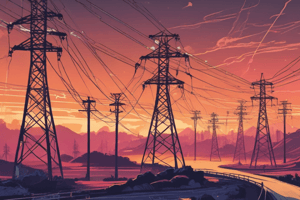Podcast
Questions and Answers
What is the reflection coefficient for best matching?
What is the reflection coefficient for best matching?
- should be negative
- equal to infinity
- equal to zero (correct)
- equal to one
Which of the following contributes to the reflected voltage?
Which of the following contributes to the reflected voltage?
- all of the choices (correct)
- Zo
- propagation constant
- length
What is the reflection coefficient of an open-circuited line?
What is the reflection coefficient of an open-circuited line?
- infinite
- 1 (correct)
- -1
- 0
What is the term for the interference of two waves going in opposite directions?
What is the term for the interference of two waves going in opposite directions?
In a step-up quarter-wave transformer matching, the load resistance is expected to be:
In a step-up quarter-wave transformer matching, the load resistance is expected to be:
The impedance at the termination of a shorted line is:
The impedance at the termination of a shorted line is:
Which expression represents the relationship of the reflection coefficients?
Which expression represents the relationship of the reflection coefficients?
Which statement is NOT characteristic of a microstrip transmission line?
Which statement is NOT characteristic of a microstrip transmission line?
What is the first step in using the Smith Chart?
What is the first step in using the Smith Chart?
An open-circuited transmission line behaves like which component?
An open-circuited transmission line behaves like which component?
In stub matching, the stub is placed ______ the primary line
In stub matching, the stub is placed ______ the primary line
Flashcards
Reflection coefficient
Reflection coefficient
The ratio of the reflected voltage to the incident voltage at the load.
Best matching in transmission lines
Best matching in transmission lines
When the reflection coefficient is zero, the incident voltage is fully transmitted to the load, and there's no reflection.
Standing waves
Standing waves
The interference of two waves traveling in opposite directions, resulting in a standing wave pattern.
Standing Wave Ratio (SWR)
Standing Wave Ratio (SWR)
Signup and view all the flashcards
Input impedance (Zin)
Input impedance (Zin)
Signup and view all the flashcards
Open-circuited line reflection coefficient
Open-circuited line reflection coefficient
Signup and view all the flashcards
Power transfer efficiency
Power transfer efficiency
Signup and view all the flashcards
Matching network
Matching network
Signup and view all the flashcards
Smith Chart
Smith Chart
Signup and view all the flashcards
Study Notes
Transmission Lines Exam Questions
-
Part 1: Matching
- For best matching, the reflection coefficient should be equal to zero.
- The reflection coefficient should not be equal to one, infinity or a negative value
-
Contributing Factors
- The reflection coefficient depends on the propagation constant and characteristic impedance (Zo).
- Incident voltage is affected by the propagation constant.
- The incident current is affected by the transmission line's length.
-
Open-Circuited Line Reflection Coefficient
- An open-circuited line has a reflection coefficient of -1.
-
Interference of Waves
- Standing waves are created by the interference of incident and reflected waves that travel in opposite directions.
-
Minimum Impedance
- The minimum impedance in a transmission line is determined by the ratio of the minimum voltage to the maximum current (Vmin/Imax).
-
Open and Short Circuits
- In an open circuit configuration, the sum of incident voltage and reflected voltage is at a maximum value.
- In a short circuit configuration, the sum of incident current and reflected current is maximum.
-
Impedance at Line Termination
- The impedance at the termination of a shorted line is undefined.
-
Quarter-Wave Transmission Line Termination
- The impedance of a quarter-wave transmission line terminated in an open circuit acts as a capacitor
-
Half-Wavelength Transmission Line Termination
- The impedance of half-wavelength transmission line terminated in an open circuit acts as a series resonant circuit
-
λ/8 Transmission Line Termination
- The impedance of a λ/8 transmission line terminated in an open circuit acts as a capacitor
-
3λ/8 Transmission Line Termination
- The impedance of a 3λ/8 transmission line terminated in a short circuit acts as a parallel resonant circuit.
-
Inductive and/or capacitive line
- If the transmission line is purely inductive or capacitive, the minimum voltage(Vmin) will appear before Smax.
-
Stub Matching
- In a step-up quarter-wave transformer matching configuration, the load resistance (RL) is greater than the characteristic impedance (Zo).
- The stub is placed away from the primary line.
-
Smith Chart Usage
- The first step when using a Smith chart is to draw the impedance circle.
-
Microstrip Characteristics
- Microscopic transmission lines are constructed with a high-grade printed circuit and have an insulating substrate.
-
Reflection Coefficient Relationship
- The relationship between incident and reflected voltage, and reflection coefficients, is determined by the characteristic impedance and the impedance of the load.
-
Expressions for Reflection Coefficient
- Not all expressions below represent the reflection coefficient;
- Multiple expressions determine the reflection coefficient values.
-
Determining First Voltage Maximum Position
- The position of the first maximum voltage is determined by certain equations.
Studying That Suits You
Use AI to generate personalized quizzes and flashcards to suit your learning preferences.




